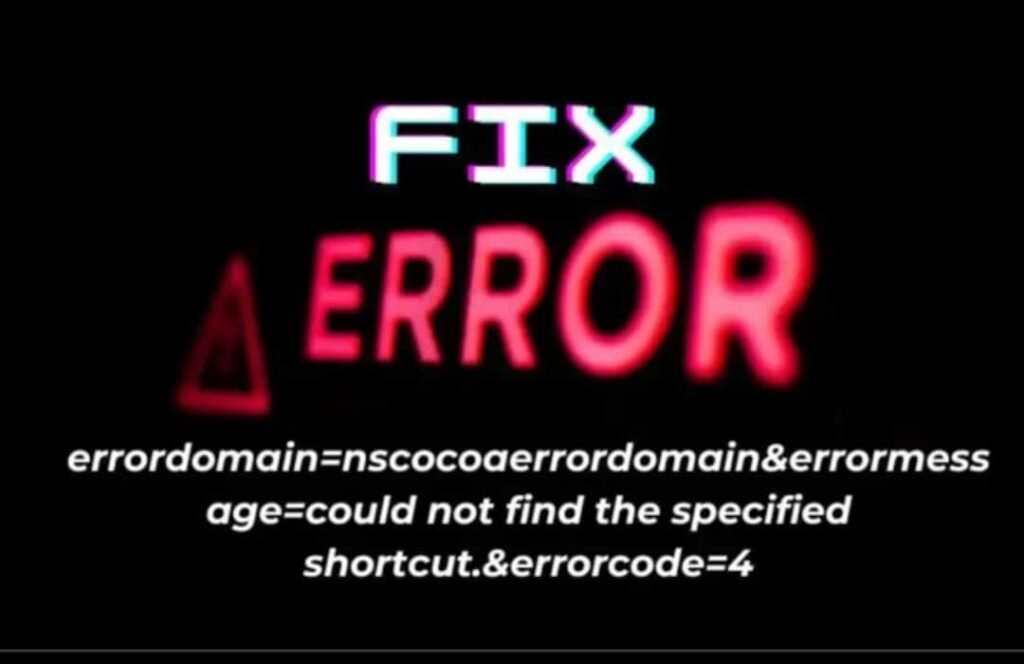Introduction
In the world of macOS and iOS development—or even daily usage—errors can pop up unexpectedly. One such cryptic message is errordomain=nscocoaerrordomain&errormessage=could not find the specified shortcut.&errorcode=4. For users unfamiliar with technical terms or developers troubleshooting complex applications, encountering this error can be both confusing and frustrating.
But what does this message actually mean? Is it related to system-level functionality, or is it tied to specific app operations? Why does it appear, and more importantly, how can you prevent it?
This in-depth article breaks down the error string piece by piece, explores its root causes, explains how to resolve it, and provides expert insight into how developers and users alike can avoid triggering it in the future.
Decoding the Error Message
Let’s start by breaking down the full string:
errordomain=nscocoaerrordomain&errormessage=could not find the specified shortcut.&errorcode=4
1. errordomain=nscocoaerrordomain
This indicates that the error belongs to the NSCocoaErrorDomain, a predefined error domain used by Apple’s Cocoa framework in macOS and iOS. Cocoa handles user-facing functionalities like file systems, UI elements, object persistence, and more. So, any error coming from this domain is typically rooted in application-level operations rather than deep system processes.
2. errormessage=could not find the specified shortcut.
This is the core message: the system or app attempted to locate a shortcut but failed. A “shortcut” in this context could refer to:
- A keyboard shortcut
- A file alias or symbolic link
- A URL bookmark
- A reference to an in-app navigation item
3. errorcode=4
Apple assigns numeric codes to different errors in each domain. In NSCocoaErrorDomain, error code 4 usually translates to “file or resource not found.” This complements the rest of the error message, confirming that the shortcut reference leads to a missing or deleted destination.
Common Scenarios Where the Error Appears
Understanding the contexts where errordomain=nscocoaerrordomain&errormessage=could not find the specified shortcut.&errorcode=4 typically shows up can help narrow down the cause quickly.
1. Broken File Aliases
If you create an alias (shortcut) to a file or folder and the original item gets deleted or moved, accessing that alias later can trigger this error.
2. App Preferences or Bookmarks
Some macOS apps, especially productivity tools, allow users to save shortcuts or bookmarks within the app. If these pointers become invalid due to updates or uninstalls, the app may display this error.
3. Keyboard Shortcut Conflicts
Applications relying on custom keyboard shortcuts or mappings might throw this error when the assigned shortcut no longer maps to an available action.
4. Migration Issues
When data is migrated from one Mac to another, certain paths or symbolic links may not survive the transition intact. Launching apps post-migration can then generate this error.
5. Development and Debugging
iOS/macOS developers using Xcode might see this when building or testing an app that tries to access a file, shortcut, or resource that has not been bundled or is referenced incorrectly.
Troubleshooting the Error: User-Level Fixes
If you’re an everyday user—not a developer—facing this error during application usage, here are some steps to resolve it:
1. Check for Deleted Shortcuts
Open Finder and search for the missing shortcut. If it’s gone, consider recreating it or restoring from backup.
2. Reset Application Preferences
If the error stems from an app-specific bookmark or shortcut, try resetting the app’s preferences by deleting its .plist file in ~/Library/Preferences.
3. Reinstall the Affected App
Sometimes, the best way to remove corrupted shortcut data is to uninstall and then reinstall the application triggering the error.
4. Clean Up Orphaned Aliases
Use tools like “Finder Alias Fixer” or Terminal commands to detect and remove aliases pointing to non-existent destinations.
Troubleshooting the Error: Developer-Level Insights
For developers encountering errordomain=nscocoaerrordomain&errormessage=could not find the specified shortcut.&errorcode=4, the following best practices and debugging strategies can help resolve it.
1. Validate All Shortcut Paths
Before executing any code tied to file paths or resource links, validate that the referenced item exists using FileManager.fileExists(atPath:) or equivalent methods.
swiftCopyEditlet path = "/Users/me/Documents/Shortcut"
if FileManager.default.fileExists(atPath: path) {
// Proceed with operation
} else {
// Handle error gracefully
}
2. Avoid Hard-Coding Paths
Instead of hard-coding directory paths, use Apple-provided APIs to locate system directories dynamically:
swiftCopyEditlet documentsURL = FileManager.default.urls(for: .documentDirectory, in: .userDomainMask).first
3. Graceful Degradation
Always assume a resource might not be found. Wrap access calls in try-catch blocks or use optionals with safe unwrapping to prevent crashes.
swiftCopyEditdo {
let content = try String(contentsOfFile: path)
} catch {
print("Error loading file: \(error)")
}
4. Use NSUserActivity and NSURLBookmarks Cautiously
These APIs store references to resources or activities. If not handled properly, broken references can lead to this error. Regularly validate and refresh stored bookmarks or identifiers.
Preventive Measures: Avoiding the Error Altogether
Avoiding errordomain=nscocoaerrordomain&errormessage=could not find the specified shortcut.&errorcode=4 is often more efficient than fixing it post-fact. Here’s how:
a. Backup and Sync Shortcuts Regularly
For users, tools like iCloud or Time Machine can ensure shortcuts are preserved even if original files are relocated or deleted.
b. Avoid Renaming Critical Files
If you depend on file aliases or symbolic links, avoid renaming or moving the target files unless absolutely necessary.
c. Use Relative Paths in Apps
App developers should favor relative paths within app bundles over absolute file system paths. This makes the app more portable and less error-prone.
d. Monitor Logs
Both users and developers can monitor system logs using the Console app or Xcode debugger. Often, contextual errors appear before or after this specific one, helping pinpoint the true root cause.
Real-World Example: App-Specific Use Case
Let’s consider a note-taking macOS app where users can assign keyboard shortcuts to jump to frequently used notes. If a user deletes or renames the targeted note and attempts to use the shortcut again, the app might throw this exact error:
errordomain=nscocoaerrordomain&errormessage=could not find the specified shortcut.&errorcode=4
To fix this:
- The user should reassign the shortcut to an existing note.
- The developer should implement error-catching to offer a user-friendly message like: “The note linked to this shortcut no longer exists. Please update or remove the shortcut.”
Conclusion
The error string errordomain=nscocoaerrordomain&errormessage=could not find the specified shortcut.&errorcode=4 might seem intimidating at first glance, but with a clear understanding of its components, it becomes manageable. Whether you’re an end user puzzled by a broken shortcut or a developer debugging a resource-loading bug, this error signals a fundamental issue: the system expected something to be there, but it wasn’t.
By practicing safe referencing, validating resource paths, and employing graceful fallback strategies, both users and developers can reduce the chances of encountering this error. As macOS and iOS continue evolving, keeping track of how shortcuts and bookmarks are handled becomes increasingly important.
you may also read: zentalblog


